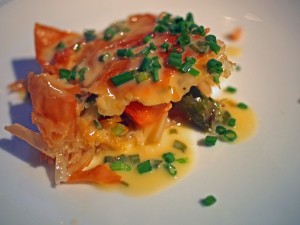
I’d be happy just to eat all of the new-season’s asparagus steamed or grilled with some butter or some parmesan – maybe with some hollandaise, some truffle oil or a squirt of lemon juice. But every now and then it’s nice to gussy things up a bit, so here is a downright swanky way with one of my favourite vegetables.
Don’t be scared of either the filo pastry crust or the beurre blanc. Both can appear to be quite intimidating ingredients, but filo (which you can buy ready-made at the supermarket) is actually very, very easy to handle; and if you follow the instructions below you’ll find the beurre blanc a breeze to make.
To serve 4 as a main course or 6 as a starter you’ll need:
Croustade
10 sheets filo pastry
150g unsalted butter
700g asparagus
500g salmon, or a mixture of salmon and another firm white fish
1 teaspoon tarragon
2 shallots
Salt and pepper
Beurre blanc
225g unsalted butter, cold from the fridge
2 shallots, sliced
1 bay leaf
3 peppercorns
5 tablespoons white wine
1 tablespoon white wine vinegar or sherry vinegar
1 teaspoon creme fraiche
4 tablespoons snipped fresh chives
Salt and pepper
Start by infusing and reducing the wine and vinegar for your beurre blanc. In a small pan, combine the wine, vinegar, the sliced shallot, the bay and the peppercorns. Over a medium heat, reduce the contents of the pan until you have only a tablespoon of syrupy liquid left. Remove the pan from the heat, discard the bay and peppercorns, and reserve the shallots.
Preheat the oven to 180ºC (350ºF) and steam the fish for ten minutes.
While the oven is heating, assemble the croustade in a metal baking dish about the same size as a single sheet of filo. Melt the butter and brush the bottom of the dish with a layer, then place the first sheet of filo on the buttered surface. Brush the top of the filo sheet with butter, add another layer of filo and butter the top of that, until you have built a stack of five buttered sheets.
Flake the steamed fish into pieces and chop the asparagus spears (discarding the woody ends) into pieces about the length of your thumb. Scatter the fish flakes and the asparagus over the filo. Dice the shallots from the beurre blanc mixture with the fresh shallots, and scatter those over too, along with a little salt, plenty of pepper and the tarragon.
Layer the remaining five pieces of filo, buttering each one as you go, over the top of the asparagus mixture. Use a knife to score the top sheets gently into squares in the size you want for serving. Put the croustade in the oven and bake for 35-40 minutes, until the top is crisp and a dark gold colour.
About 15 minutes before the croustade is ready to come out of the oven, make up the beurre blanc. Chop the cold butter into pieces about the size of the top joint of your thumb (there are lots of finger measurements in today’s recipe). Stir the creme fraiche into the wine and vinegar reduction you set aside earlier, and put it over a medium heat.
Drop three of the butter pieces into the reduction, and whisk until they are half-melted. Drop another three in and continue to whisk until the original three pieces have melted completely, then add another three. Continue to add the butter pieces three at a time, whisking hard, as the ones you have put in before melt, until the butter is all incorporated. Remove from the heat and stir through most of the chives, reserving two teaspoons to garnish. Taste for seasoning, adding extra salt and pepper or a little lemon juice if you think it needs it.
Use a sharp-edged spatula to divide up the croustade along the marks you made earlier, and spoon some of the beurre blanc over each serving with a little sprinkle of chives. Serve immediately.
